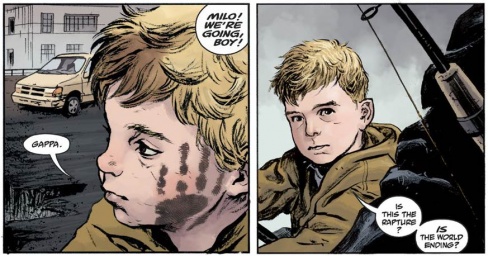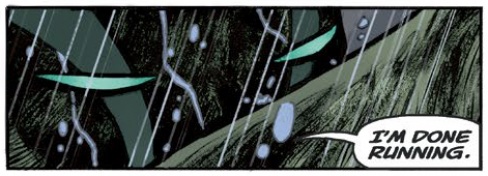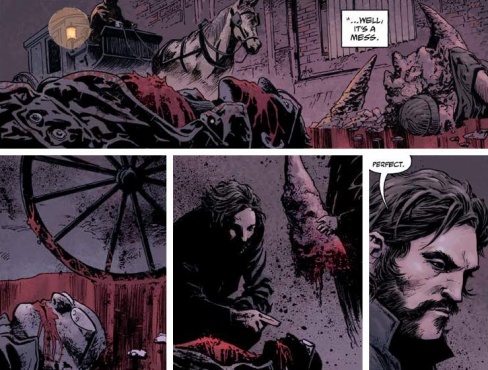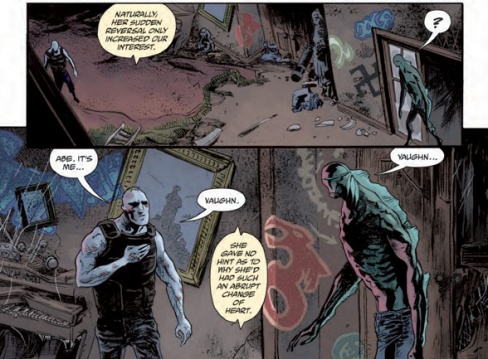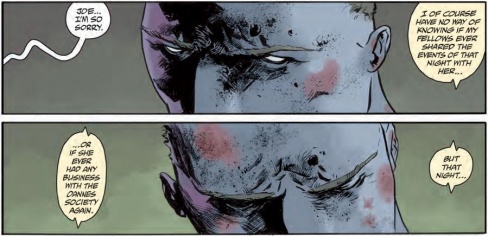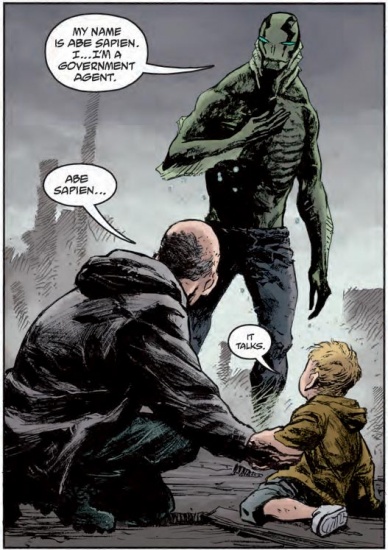
The “Dark and Terrible” cycle of “Abe Sapien” comes to an end in “The Desolate Shore.” Brace yourself for spoilers ahead, we’re diving in deep into this one…
Written by Mike Mignola and Scott AllieCover by Sebastián Fiumara
Illustrated by Sebastián Fiumara
Colored by Dave Stewart
Lettered by Clem RobinsThe future of mankind hangs in the balance as Abe Sapien finally comes ashore to face the necromancer who’s figured out how to use Abe’s role in the apocalypse to his advantage.
Mark Tweedale: This is going to be an odd review, I think. I mean, we’re going to be talking about this final issue, but also about the “Dark and Terrible” cycle as a whole. After all, this is the end of that story, and we can’t properly evaluate an ending without the context of the series as a whole.
But first, let’s talk about the opening scene with Milo and his uncle, Richard. We’ve seen these two before, back in the opening pages of “The Black School,” a scene which left both of us going ‘Huh?’ It was a scene that seemed to have no reason for being there, but in retrospect it becomes the device through which we gauge how long Abe was in England for. Milo’s grown up in all that time.
Mike Romeo: Yeah, it was helpful in that way, but I still found it to be a head-scratcher. It’s gotta be a third of the issue is spent with these two, while other story elements seemed to either be rushed or wedged in. I mean, we got to spend more time with Milo than another, seemingly more important character. I dunno, as of this moment, I’m feeling let down by this finale, and am hoping you can show me something I’m missing.
Mark: I wish I could, but I can’t. This issue would have benefited from leaving Milo and Richard after the B.P.R.D. helicopter flies overhead, because throughout the rest of the book, their presence seems perfunctory to me. Abe meets them and explains things the reader already knows, then gets into a fight that puts Milo and Richard in peril, but their peril doesn’t do anything for Abe’s story. It’s just another thing that happens. The issue would have been tidier, and had more page space to play with, if Milo and Richard hadn’t appeared after the second page. Ideally a B plot like this should reflect or accentuate an element of the A plot, but that wasn’t the case here.
Sometimes more is just more, and it dilutes the focus of a story. And considering this is the final issue of a thirty-plus-issue arc, this needed to be tightly focused.
This issue was a problematic ending for the series in a lot of ways, but mostly it’s not really a fault with this issue. Problems in a story’s ending are usually symptoms of problems in the beginning and the middle, and I think that’s certainly the case here. If you’ll forgive me, I’m probably going to be talking a lot about prior issues in relation to this final issue.
Mike: No need to forgive, because I couldn’t agree more. I feel that, after a few strong arcs, this issue fell headlong into the worst tendencies of the series. Things happened simply because they needed to, important stuff didn’t get enough attention while inconsequential stuff got too much, and the whole thing just felt unfocused. Worst of all was the volume of needless exposition, which I found to be really surprising. Here we are, in the midst of what should be a huge finale, and we’re having our hand held. As you mentioned already, we got a dose of it with Milo and his uncle, and then Strobl comes barging in looking to tell us his life story. Which, for what it’s worth, was just told a handful of issues ago.
But that’s a far cry from the most frustrating part of Strobl’s role in the issue. What do you say, want to get into some spoilers?
Mark: Yeah, let’s dive into spoilers, but before we dive into talking about Strobl, I’ve got to talk about Abe, because Strobl’s entire existence in this series serves to support Abe’s overall character arc.
Continued belowLooking at the series from start to finish, it’s clear that this story is about Abe accepting his role in what’s to come. The series began with Abe running away and culminated with this moment at the end:
Ultimately “Dark and Terrible” is about Abe’s personal journey. This was a story about Abe lying to himself, going through a years-long period of self-discovery and examination. This the lens I’m going to be looking through as I evaluate this issue and the series as a whole.
OK, so let’s get back to Strobl, specifically back to Strobl at the end of “Regressions” (issues #32–33). In “Regressions” Strobl bound Abe with magic, and there was nothing Abe could do about it. For a moment Abe was like a worm on a hook. And even when Abe broke free, all he could do was run and hide and nurse his wounds.
Since then Strobl has undergone a transformation, becoming a Sapien creature (for lack of a better term). Both issue #34 and #35 ended in ways that teased what he was becoming, the power he had stolen, and the threat he represented. Yet his confrontation with Abe was nothing more than a wordy fist fight. Honestly, Strobl was more threatening when he was a human necromancer in “Regressions.”
The other problem with Strobl is one of emphasis, in particular the emphasis of time and investment. We invested over thirty issues into Gustav Strobl only to have his end boil down to a fist fight. The beginning and middle of the series didn’t lay the groundwork for such a straightforward ending.
In terms of his narrative function, Strobl is a pretty simple villain. Don’t get me wrong, he has a detailed backstory and character motivations, but his role in Abe’s story and the “Dark and Terrible” cycle is simple: he exists to show Abe what will happen if he doesn’t act. Once Abe sees that and declares that he’s done running, Strobl has no story function anymore and is killed off on the next page. Literally the very next page.
Honestly, I think the story would have been better served if Gustav Strobl appeared in the first three issues of “Abe Sapien” up to the point where he collected the dead Agent Vaughn, and then didn’t appear again until the 1983 flashback in “Abe Sapien” #30, because all the time we spent investing in his story over-inflated his role in the series. Yes, there were many great moments with Strobl on the way to this ending, but those moments don’t serve the overall story or the ultimate ending. Looking back, there’s nothing that Strobl learns in issues #4–29 that he couldn’t have learnt in issue #31 when he visited the Black School or learnt from Vaughn in scenes entirely suggested by a few well-chosen lines of dialogue.
Speaking of Vaughn, his character arc is an excellent example of this problem of inflated significance. His death in issue #33 left me cold, but I said nothing at the time, because I wondered if the remaining issues would do more with it. Obviously that wasn’t the case. But why did it leave me cold? I mean, if I look at Vaughn’s death scene in isolation from the rest of the series, it hits all the right notes perfectly. Perfectly. The problem wasn’t in the final scene, it was in the set-up. By spending all those issues watching him suffer and struggle, such a small ending wasn’t enough anymore.
But imagine how differently that scene would have played if the last time we had seen Vaughn was in issue #3 when this happened…
…and the next time we see Vaughn it’s this moment in issue #33…
We don’t need those middle scenes of suffering, because his suffering is written all over his body. We don’t need to see him fight against Strobl’s control because it’s in his eyes in this moment.
Without all those middle scenes, Vaughn’s story is still there, and more powerful because it’s distilled down to its essence. The difference is we haven’t had nearly thirty issues in between these two moments where Vaughn’s story is built up into something more than it is. Vaughn’s death in issue #33 wasn’t a surprise because it was an unexpected turn of events—in fact, it’d been signposted since issue #4—it was a surprise because after investing so many pages into his story, I expected more, and that expectation distracted from the tragedy of Vaughn’s prolonged life and the casual way in which Strobl discarded him.
Continued belowYou can tell how important Vaughn was to the plot by the impact his death had on Abe: it matters for that one moment, and then it’s like it never happened.
Mike: You’re spot on with the criticism of Vaughn’s death, and I think the conclusion of his arc mirrors Strobl’s. So much effort was put into their stories, only for both of them to be quickly and unceremoniously shuffled off of the stage. The difference between the two, and why I find Strobl’s end more frustrating, is that Vaughn was a character who existed on borrowed time. A necromancer reanimated him so, even though his end was sudden, I realized that it really could have come at any time. On the other hand, Strobl spent the entire time amassing power, ultimately achieving something that I’d consider to be pretty monumental. Then, at the height of his power, he was killed in a way that seemed so… unimportant.
I feel like the whole Strobl v. Abe scene lacked heart in every way possible. The dialogue was trite and the art was less than I expected. It felt like Fiumara lost steam as the fight was going on. He’s usually so good with his acting, but by the time we get to the sequence of Abe impaling Strobl on the rock it seemed that both the artist and the character were as bored as I was.
I’ve got some more I’d like to say about the execution of this issue, but let’s take a minute and talk about where we are in regards to Strobl and the wider narrative. Clearly, my assumption is that he’s dead, but I’m curious about whether you agree with me.
Mark: I think he’s dead. He’s come back to life before, though, so I guess he could come back. We really have no idea what his current form is capable of.
Mike: And that’s such a bummer! This issue should have been where we got a clearer idea of what his new form meant and how it could affect Abe’s story post “Hell on Earth,” right? Instead we get this weird, hasty dismissal.
And speaking of hasty, how about that quick clean up at the end?
Mark: Yeah, I don’t know what to make of it. This whole series feels like a middle act. The beginning was external, kicking off in the pages of “B.P.R.D. Hell on Earth,” and its ending is going to be external too (despite the text in the final panel saying ‘the end’). Abe’s going back to the B.P.R.D. whether he likes it or not.
To me, the ending feels tacked on. I mean, you could literally go to any point in the series and have B.P.R.D. agents rock up to take him back to headquarters. It’s an event completely external to Abe’s story. And to have it happen right after Abe had made his big choice not to run any more… it just felt contrived. I didn’t like that the choice to go back was taken away from him, especially after the whole ‘I’m done running’ moment. I wanted an ending that was more thematically consistent with the series as a whole. And that goes for the fight with Strobl too.
Consider how Abe defeats Strobl. Abe gets angrier and angrier until he snaps and beats the shit out of him. This is the culmination of Abe’s journey from issue #1, a journey that began with Abe choosing not to use a gun, that saw him time and time again refuse to fight, and on the occasions that he lost his temper, it made him monstrous or made the situation worse in some way. The way Abe defeats Strobl does not demonstrate change. If anything, it shows him giving in to the impulses that have kept him from moving forward throughout the entire series.
In a story that has been so focused on a character’s journey of self-discovery, the final conflict in the series should be resolved by a fundamental change in its central character. Instead we have a fight that I imagine would play out almost exactly the same way if the Abe from issue #1 had been in this situation. Literally the only difference is that issue #1 Abe would not have said ‘I’m done running.’
Continued belowThe thing is, it’s not enough to say it. We need an action that demonstrates that change in such a way that even if Abe were to say nothing, we’d still understand he had finally accepted his role. As much as Abe doesn’t want this role, there will always be someone out there that does want it, and they’ll take it and unleash horror on the world. Only in assuming his role can Abe truly protect the world from usurpers like Strobl.
Abe didn’t win because he had changed. He won because the plot needed it.
I needed more than words.
Mike: See, I don’t view the ending as having taken the choice away from him. The opening of the sees Abe confirm that he’s with the B.P.R.D., which makes me feel that he’s en route to the base.
That doesn’t make the agents’ role any less weird, though. They’re faceless and Abe is unconscious, which gives the Bureau more of a men-in-black feeling than I can ever recall in any of these books. It almost seemed sinister. If Abe had been wounded but awake he could have put a hand on a friendly shoulder, or given them an, ‘I’m ready,’ right? Plus, the agent calling him, ‘this thing’ felt really out of place. I mean, Abe is one of the longest serving agents in the Bureau, yet he’s being regarded as some ‘thing.’ I’d imagine that there’d be at least enough reverence for the guy to keep someone from making that sort of comment.
Mark: Yeah, it was a cold ending, although your observation that Abe was probably already on his way back to base makes me like it slightly more. It’s just such a shame to see the series stumble at the end. I’ve really been enjoying it lately. Anything more you want to add before we grade this one?
Mike: Nah, I think I said my piece. Despite the shortcomings I mentioned earlier, I think that Fiumara and Stewart did a good job on this one, but it wasn’t enough to make up for the shortcomings in the writing. This one earns a 5 from me.
Mark: I was dissatisfied with this ending for a number of reasons. I saw some interesting ideas that didn’t really find their legs, but I still enjoyed the issue, even though I wanted so much more. And as you say, Fiumara and Stewart did a good job. Actually, Dave Stewart did a phenomenal job throughout this series. I looked back over the previous issues before launching into this review, and I was stunned by his work.
If you look throughout his run, scenes where Abe is aimless are yellow and his skin is army green; in scenes where Abe is open to learning the truth, greens and blues appear and his skin tone becomes more saturated; Grace’s turmoil is orange; most of the scenes with Strobl have fuchsia and purple in them to the point that if you look at the pages as thumbnails, you can identify his scenes at a glance. Stewart’s colors blew me away in this series, and that really needed to be said.
I’m giving this issue a 6.
Final verdict: 5.5. Unfortunately, the series came undone at the end.


